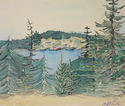
19th, 20th & 21st Century Fine Prints
707-546-7352 · fax 707-546-7924 · web: www.annexgalleries.com · email: artannex@aol.com
Betty Bierne Parsons Biography
Betty Bierne Parsons
American
1900–1982
Biography
Artist and gallerist Betty Parsons, née Betty Bierne Pierson, was born on 31 January 1900 in New York City. A precocious child, Pierson attended the esteemed Miss Chapin's School, a private grade school catering to wealthy families that, despite its reputation, left Pierson bored. A fateful trip to New York's historic 1913 Armory Show, the first large exhibition of Modern art in the United States, proved to be the inspiration Parsons needed. At the age of thirteen, Pierson began taking private art lessons. Painter and sculptor Gutzon Borglum was her first mentor--whom she later described as a poor teacher.
Pierson married socialite Shuyler Livingston Parsons in 1919. The couple moved to Paris where she continued to study on her own. Upon divorcing in 1922, Parsons remained in Paris and enrolled at the Académie de la Grande Chaumière. She studied sculpture under Emile Antoine Bourdelle and Ossip Zadkine, and in the summers she traveled to the Barbary coast to study painting with Arthur Lindsay.
During the Great Depression, she lost her fortune, and with it, her home in Paris. She returned to the United States in 1936. Not without drive and skill, Parsons traveled directly to Santa Barbara and taught sculpture for a brief time before returning once again to New York for her first solo exhibition at the Midtown Gallery. She soon secured a job at the gallery of Mary Quinn Sullivan, a trustee of the Museum of Modern Art. In 1940, Parsons took a managerial position at the contemporary gallery located in the Wakefield Bookshop where she represented the works of Saul Steinberg, Adolf Gottlieb, Alfonso Ossorio, Hedda Sterne, Theodoros Stamos, and Joseph Cornell. In 1944, art dealer Mortimer Brandt approached her about starting and managing a contemporary art division at his gallery. Upon his move to England at the end of World War II, Parsons subleased the space and opened her own gallery in 1946 at 15 East 57th Street, New York.
The Betty Parsons Gallery proved to be among the most lasting, crucial art spaces in Manhattan. Recognizing the importance of artists whose work was not yet de rigueur, she exhibited and often helped launch the careers of artists such as Mark Rothko, Jackson Pollock, Robert Rauschenberg, Ellsworth Kelly, Helen Frankenthaler, and Judith Godwin, among many others whose names would become synonymous with the major art movements of their time. After the Abstract Expressionist movement, another wave of artists including Jasper Johns, Walter Tandy Murch, and Leon Smith would also be featured at the highly coveted space. Parsons would run the gallery until her death in 1982.
Even as Parsons shaped the art world of America, she continued to work as an artist. Her style changed in the 1950s from landscapes and realism toward abstraction. In 1947, she began constructing three-dimensional works from found objects. Parsons showed at the Anita Shapolsky Gallery and the Spanierman Gallery in New York, the Virginia Miller Galleries in Florida, and the Whitechapel Art Gallery in London. She continued to show at the Midtown Gallery in New York throughout her career. Two major retrospectives were held in her honor: one at the Montclair Art Museum in 1974, and the other at the Pollack-Krasner House and Study Center in 1992. Her work is included in the permanent collections of the Museum of Fine Arts, Houston, Texas; the Museum of Modern Art, and the Whitney Museum of American Art, New York; and the Smithsonian American Art Museum and the National Museum of Women in the Arts, Washington, D.C.
Betty B. Parsons died on July 23 of 1982 in New York.




